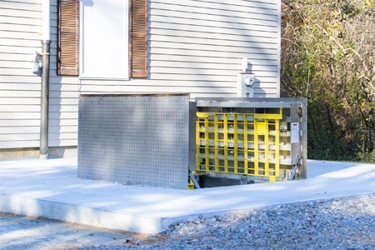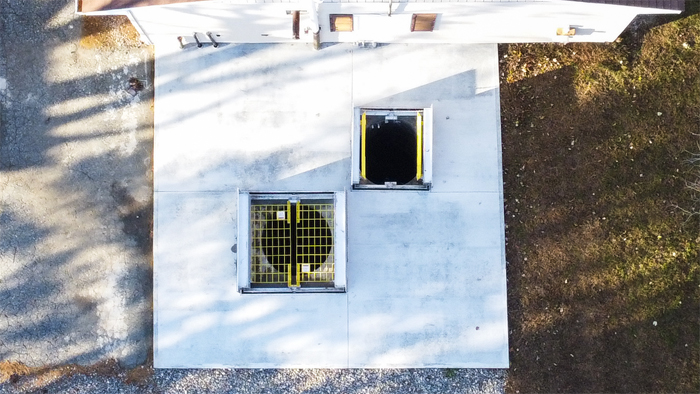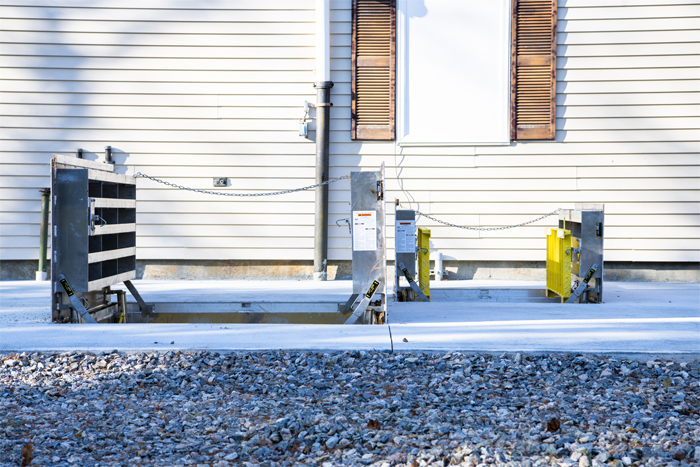Connecticut Town Takes A Step Toward Preventing Deadly Slips
By Thomas Renner

Fall grate protection on access doors improves safety
John Ramos knew his way around the wastewater treatment plant in Ruidoso, New Mexico. He retired in 2008 after rising to the rank of the plant manager, and returned in 2010 as the plant operator/lab technician operator. He worked at the plant for more than 30 years, and was respected for his “wealth of knowledge and leadership,” according to his 2016 obituary.
The manner in which he died stunned the community of about 8,000 that sits just about 150 miles from the border of Mexico. Ramos, 63, fell into a tank that holds 60,000 gallons of sewage sludge. He was cleaning a 22-foot-deep reverse activated sludge basin as part of routine maintenance when he slipped, fell into the tank, and died. “It truly was a fluke accident,” said Kerry Gladden, a spokeswoman for Ruidoso told KOB-4 television. “There was a safety line thrown in when he went in, but he never resurfaced. What’s in the tank is highly toxic.”
Ramos’ unfortunate accident illustrated the danger of work in wastewater treatment plants. Slips and falls are common, and sometimes deadly. In 2020, workers at wastewater treatment plants died in at least five states, ranging from New York to California. The U.S. Department of Labor reports work at wastewater treatment plants is among the top 10 most unhealthy jobs.
Worker safety was among the considerations in Waterford, Connecticut, when city utility managers authorized the replacement of nine doors at its water treatment plants. The project, which was completed last year, included the removal of existing doors and replacing them with doors manufactured by The BILCO Company that include fall protection grating. The decades-old doors the town replaced lacked fall protection.
“The old hatches were not required to have fall protection,” said Jim Bartelli, Assistant Director of the Waterford Utility Commission. “When the hatches are open, workers could possibly trip and fall into the opening. The new hatches have fall protection provisions that meet Occupational Health and Safety Administration standards.”
Access To Wells
Workers at wastewater treatment plants are frequently required to access wet wells, which contain chambers to receive and hold sewage until it is pumped out. The wells contain submersible pumps, and the depth of the well varies, depending on the depth of the incoming sewage inlet.
Valves to stop incoming sewer lines for inspection, repair and cleaning are also included in wet wells. There are also switches for motors, cables, sewage level indicators, and guide pipes. Workers access the wells to repair and replace equipment.
Many water treatment agencies are also now wrestling with disposable wipes that are flushed down toilets, requiring even more time for well access. Wipes snag on sewer pipe imperfections, and catch passing debris and grease that will enlarge and eventually clog pipes. They also get drawn into pumps at the water treatment plants. The only way to remove them is through manual labor. The problem costs U.S. utilities up to $1 billion annually, according to the National Association of Water Agencies.
Clogging from wipes caused a temporary, 15-mile road sewer bypass to collapse, causing a sinkhole. The sewer line collapse condemned three houses and caused officials to urge more than 500,000 residents and many businesses to curb water use for months.

The doors, which are a variety of sizes, have a wider opening for easier access to wet well controls. (Credit: Bliss Photography & Studios)
Fall Protection
The doors used in the Waterford project include factory-installed fall protection grating. The grating, which can also be installed on existing doors, meets requirements for OSHA for fall protection and allows workers to safely inspect underground areas.
“This was a pretty simple project,” Bartelli said. “But it was something that we prioritized. We want to stay ahead of the curve. The biggest issue is not necessarily the wet well hatches, but in trying to manage these flushables. It is the number one issue in our industry. This will make it a little bit easier and safer.”
The BILCO doors used in the replacement averaged 4 feet by 5 feet and were installed at-grade to allow access to the wet wells. “The BILCO doors have a much wider opening, which will allow better access to the wet well for removing debris from the wet well baskets,” Bartelli said.
Bartelli said the doors also seal better, which is especially critical in that one of the town’s stations sits in a floodplain area. Waterford, nestled adjacent to Long Island Sound, sits just 46 feet above sea level. The town is at 54 percent risk of at least one flood over 6 feet taking place before 2050, according to riskfinder.climatecentral.org.
Work on the project included the removal of existing doors, excavating around the perimeter, re-pouring concrete, and some asphalt repair. Work needed to be done in stages because the pump stations are active work sites.
BILCO’s doors include a channel-frame finish and are used in situations where there is a concern of water or other liquids entering the access opening. The doors come in single- and double-leaf sizes, and feature aluminum construction and stainless steel hardware.
“This was a project that was part of our capital plan,” Bartelli said. “A study was recently conducted and over a period of time, many of our wastewater pumping stations could be impacted by tidal water levels. We needed to expand our water-tight manhole covers and install these hatches. In the event we do have a problem with tidal flooding, we will not be bringing seawater into the wastewater system.”

The doors included factory-installed fall protection grating. (Credit: Bliss Photography & Studios)
Reducing Risks
The very nature of the job — working near water — creates danger. Workers climb on ladders, walk across elevated surfaces and need to access hard-to-reach areas. They also step on to storage tanks, vehicles, and roofs. “Slippery When Wet” is a common traffic sign, but it also applies to the daily tasks of workers at water treatment stations. As the Ramos tragedy shows, even the most experienced worker can take one misstep that can prove fatal.
The doors can also be slippery due to corrosion. Contaminants and moisture create a highly toxic environment, and expedites corrosion. A plant in Florida replaced doors on its facility in 2020 after the doors had become a fall hazard due to corrosion and decay caused by the harsh environment.
Some health hazards, such as noxious fumes, cannot be solved with fall protection or new door installation. Workers also need to avoid unnecessary risks with their health.
The Waterford project demonstrates that some communities are doing their part to ensure worker safety and helping to prevent employees from accidental and avoidable jobsite death.
Thomas Renner writes on topics related to building, construction, engineering, and water management for various publications throughout the U.S.
